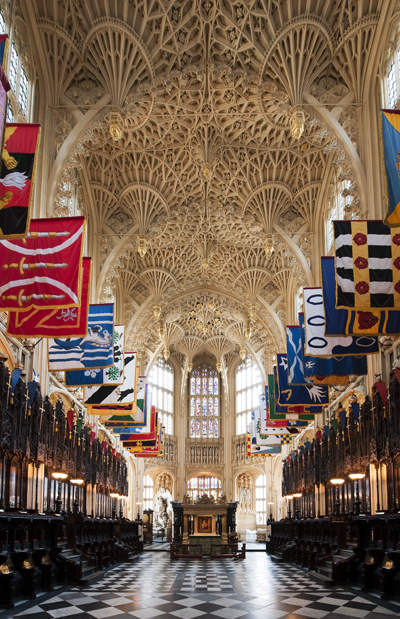The Queen's Coronation: The Coronation Church by Lawrence E. Tanner
From the Country Life Archive: Lawrence E. Tanner, Keeper of the Muniments and Library of Westminster Abbey, writes on the magnificent Collegiate Church of St. Peter at Westminster. Originally published in the Country Life Coronation Number, June 1953.


RETURN TO THE CORONATION HOMEPAGE
When the King's master mason, Henry of Reynes, planned the present Abbey Church of Westminster about 1245 he was faced with a difficult task. Not only had he to pull down the great church built by Edward the Confessor, but he had to plan on the same site a church after the pattern of the new French cathedrals, which would conform to the ground plan of the existing monastic buildings grouped around it. He had also to join on his new church, not too obviously, to the Lady Chapel which King Henry III had built some few years before. Nor was this all. Although Westminster was primarily the church of a great monastery, and the daily requirements of the monks came before anything else, it was also pre-eminently a royal church. Within it took place coronations and other great ceremonies, and for these adequate space had to be provided. It is the measure of the genius of Henry of Reynes that he solved all these problems, and that there emerged a building of incomparable loveliness, "triumphantly English" as Lethaby called it, and with a wealth of internal decoration in sculpture, glass and painting hitherto unknown in England.

Westminster Abbey: The Choir and Sanctuary, where the ceremony of the Coronation takes place, seen from under the organ screen.
Click the image above to purchase from the Country Life Picture Library
In planning for coronations it is probable that Henry had in mind the newly completed choir of the cathedral church of Rheims. There alone among Gothic French cathedrals the choir is placed west of the central crossing, and exactly the same plan was followed at Westminster. The reason was the same in both churches. It is in this central space, between the high altar and the choir, that our kings and queens are crowned. The decision of William the Conqueror to be crowned at Westminster set a precedent which has been followed ever since. Dean Stanley pointed out that no other church in the world has so unbroken a record. Coronations at Rheims are now but an historic memory, and the successors of St. Peter receive the Papal Tiara in a church which was rebuilt in the 16th century, but from the 13th century to the present day coronations have taken place at Westminster within the present abbey church.
It might have been expected that so great and solemn an event as a coronation would have been frequently depicted within the abbey church in sculpture, in glass or in mural painting. But this is not so. There may, indeed, have been coronation scenes in the windows ruthlessly smashed at the Reformation or by Cromwell's soldiers, but, apart from this, in only two places within the Abbey do there remain today representations of mediaeval coronations. On the mid-15th century stone screen which separates the sanctuary from the Confessor's Chapel there is a series of fourteen carved scenes representing incidents in the life of the Confessor. The third of these is a spirited little representation of his coronation. The king is seated under a cloth of estate. Two mitred prelates support the crown on his head, while no fewer than eighteen little figures stand to the left and right, one of whom holds an archiepiscopal cross.
More important, and indeed unique, are the coronation scenes on the Chantry Chapel of King Henry V. This chapel, which is at the east end of the Confessor's Shrine, is in two stages with the king's tomb below and an upper chapel above, so ingeniously contrived that it also spans like a bridge the ambulatory beneath. It was designed by King Henry himself during his lifetime and was carried out by John Thirske, master mason, between 1438 and 1450. The northern and southern façades of the chapel, forming the bridge over the ambulatory, consist of a series of small figures each under an elaborate canopy, with the king's badges (the beacon, swan, antelope) above and below them. The rows of figures on each side are interrupted in the centre by a triple canopied niche, three feet wide, containing a coronation group. There were originally 56 of these small figures, each about 21 inches high, of which 53 remain, and the remarkable thing about them is that they are in direct relation to, and form part of, the coronation groups which they surround.
Sign up for the Country Life Newsletter
Exquisite houses, the beauty of Nature, and how to get the most from your life, straight to your inbox.

King Henry VII's Chapel, an outstanding example of early Tudor Gothic.
Click the image above to purchase from the Country Life Picture Library
It is worth while to examine these two groups in detail. On the south side the king is seated in his parliament robes with the orb in his right hand and a broken fragment of the rod with the dove in his left. His crown is supported by the Archbishop of Canterbury (Arundel) and by the Abbot of Westminster (Colchester), both of whom wear copes and mitres. Almost all the small figures on this side have long gowns and mantles and wear hoods on their heads with dagged liripipes. At a modern coronation this would have been the moment when the peers put on their coronets. But the late Sir William Hope pointed out that at the time of the Coronation of Henry V in 1413 very few peers had distinctive coronets denoting their rank in the peerage. We have here, therefore, a representation of what is probably a far older custom from which the present custom has sprung, namely, that at the moment of crowning all these little figures of peers have simultaneously put their hoods on their heads.
On the north side the king is again represented seated and crowned and in his parliament robes. His hands are broken off, but no doubt they originally held the sceptre and the rod. The two prelates now steady the crown and support the king's arms. On each side of the king there kneels a peer, and two standing peers complete the group. The two kneeling peers wear what are in fact very early representations of the robes still worn by peers of the realm. The whole scene must represent the homage. On this side almost all the small figures are bareheaded. The one hooded figure has probably strayed at some time from the south side. The other figures represent a bishop, judges with coifs on their heads, and peers.
These extraordinarily interesting groups by no means exhaust the statues which enrich the Chantry Chapel. Mention may here be made of the two delightful representations of the king on horseback in full armour galloping over a stream and across country. He wears a helmet encircled by a crown, and this recalls the tradition that the Black Prince's Ruby now in the Imperial Crown was one of the rubies which are known to have been set in the crown which encircled the helmet worn by the king at the Battle of Agincourt.
It is remarkable that in a royal church such as Westminster there are no statues of English kings such as adorn, for instance, the choir screens at Canterbury and York. It may be that there was formerly such a series on the north front and it is believed that Dean Williams, at the beginning of the 17th century, replaced them with "elegant statues" of kings and benefactors. But these, too, have been replaced by modern statues. There are, of course, many mediaeval representations of individual English kings, apart from their tomb effigies, within the Abbey. Of these, as might be expected, the most numerous are the statues of Edward the Confessor. But pride of place must be given to the great painted portrait of Richard II which now hangs in the nave. The Westminster tradition is that the portrait was given by Richard himself to the Abbey of which he was always a generous benefactor. Sir Sydney Cockerell and the late Professor Lethaby suggested that it was the work of André Beauneveu, of Valenciennes, a Flemish master of the latter part of the 14th century who worked for the Duke of Berry. Others believe that it is English work. But however this may be it remains a striking and impressive portrait of the youthful king. A small early portrait painted on a panel of his supplanter and successor, Henry IV, was presented to the Abbey in 1906 and now hangs in the Jerusalem Chamber, where he died in 1413.

The abbey church of Westminster, where British sovereigns have been crowned for over 900 years.
Two other royal portraits may be mentioned. Inside the north transept, immediately over the centre column of the main door, at the intersection of the arches, is a corbel head of a young king or prince wearing a circlet. The head is a remarkable one and has evidently been carved with considerable care. It has been thought to represent Henry Ill's son, the future Edward I. Much later in date, but equally remarkable in its way, is the almost full sized figure of a king in the north aisle of Henry VII's Chapel. This is one of the great series of saints and kings which adorn the chapel, but the face is one of marked individuality. The king wears an elaborate crown. He carries a foliated sceptre in his right hand, while he reads from a book supported by his left hand. The figure is different in many ways from the others in the series. Since it stands in a niche next to that containing a statue of St. Armil, a Brittany saint whom Henry VII greatly venerated, it may represent King Henry himself, the builder of the chapel.
RETURN TO THE CORONATION HOMEPAGE
READ: THE CROWNING DAY BY IVOR BROWN
READ: IN THE ABBEY BY JOHN BETJEMAN
READ: A PORTRAIT OF QUEEN ELIZABETH II
READ: A PORTRAIT OF THE DUKE OF EDINBURGH
Agnes has worked for Country Life in various guises — across print, digital and specialist editorial projects — before finally finding her spiritual home on the Features Desk. A graduate of Central St. Martins College of Art & Design she has worked on luxury titles including GQ and Wallpaper* and has written for Condé Nast Contract Publishing, Horse & Hound, Esquire and The Independent on Sunday. She is currently writing a book about dogs, due to be published by Rizzoli New York in September 2025.
-
 Two quick and easy seasonal asparagus recipes to try this Easter Weekend
Two quick and easy seasonal asparagus recipes to try this Easter WeekendAsparagus has royal roots — it was once a favourite of Madame de Pompadour.
By Melanie Johnson
-
 Sip tea and laugh at your neighbours in this seaside Norfolk home with a watchtower
Sip tea and laugh at your neighbours in this seaside Norfolk home with a watchtowerOn Cliff Hill in Gorleston, one home is taller than all the others. It could be yours.
By James Fisher